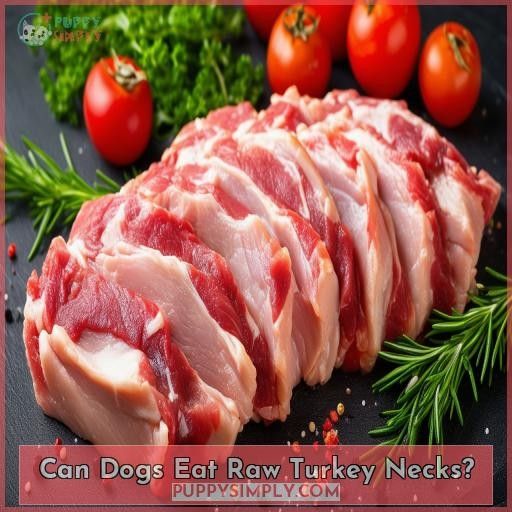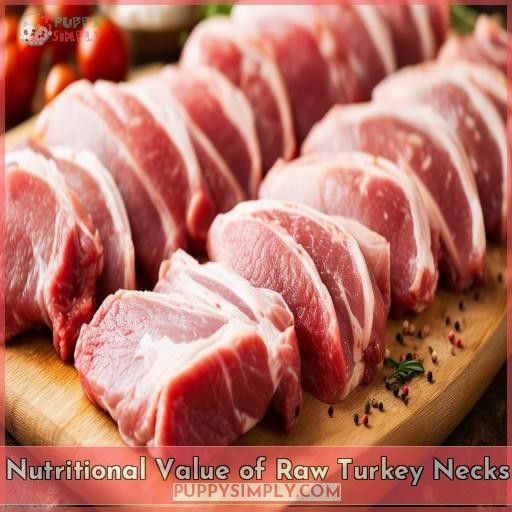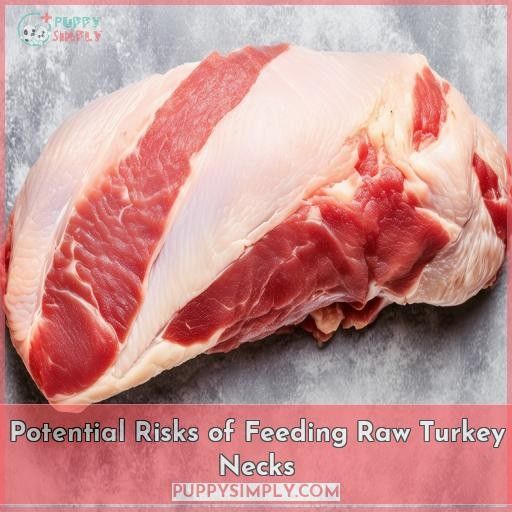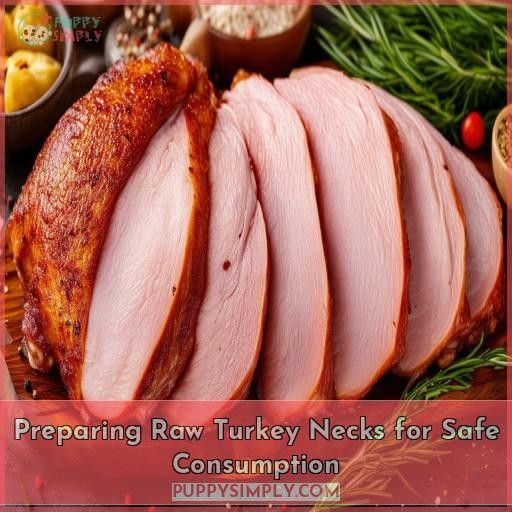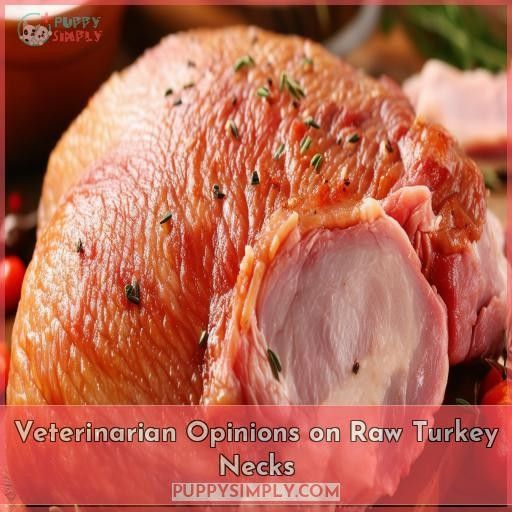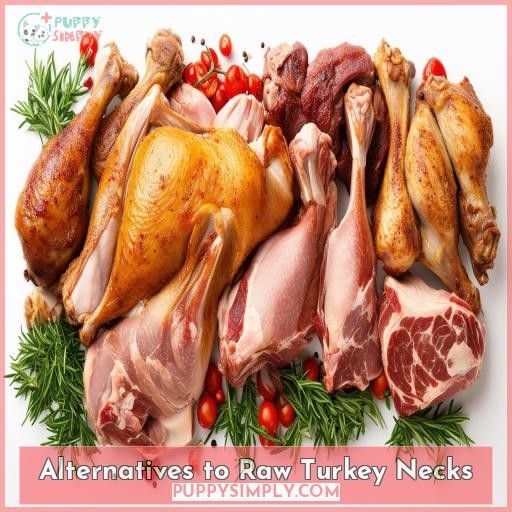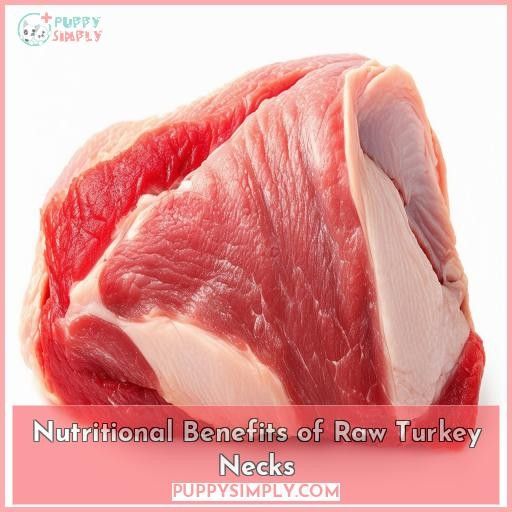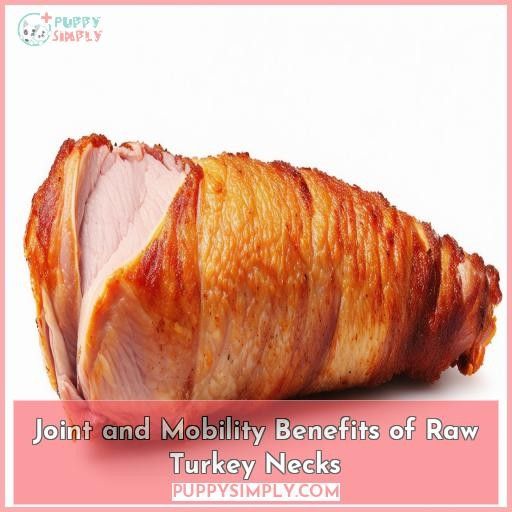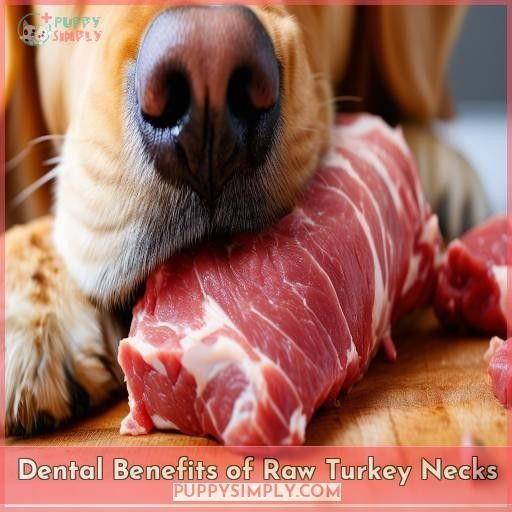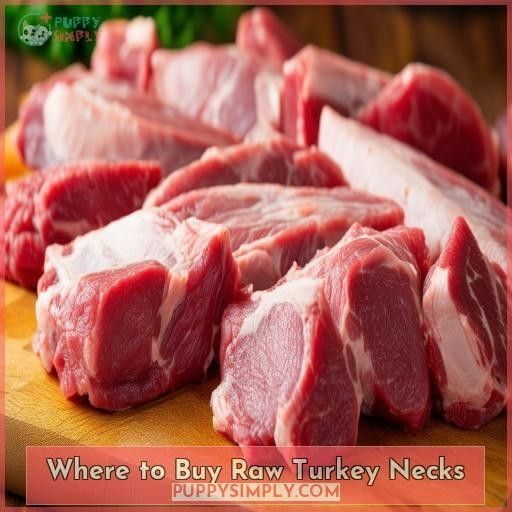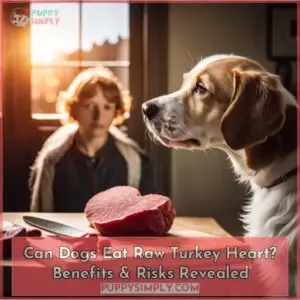This site is supported by our readers. We may earn a commission, at no cost to you, if you purchase through links.
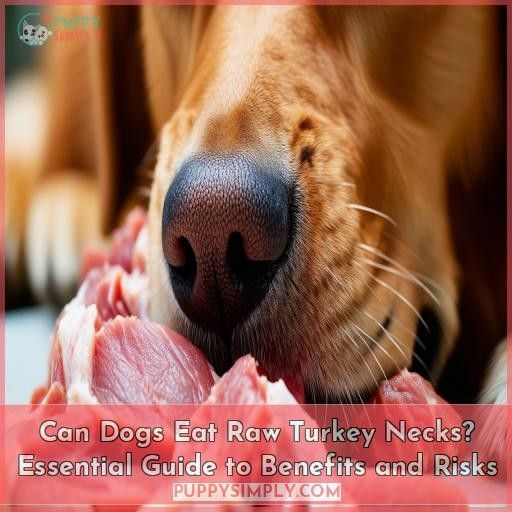 You can feed your dog raw turkey necks, but there are risks to bear in mind.
You can feed your dog raw turkey necks, but there are risks to bear in mind.
These nutrient-dense treats are high in protein, calcium, and amino acids that support muscle, bone, and joint health.
However, they pose choking hazards, digestive blockages, bacterial contamination, and splintered bones that may cause internal injuries.
Preparing them safely involves rinsing, trimming excess fat, cooking thoroughly, and cutting into bite-sized pieces.
While some vets recommend them for dental benefits, others advise caution based on your dog’s individual needs and abilities.
If you’re still unsure about the potential pros and cons, let’s explore alternative options that prioritize your pup’s wellbeing.
Table Of Contents
- Key Takeaways
- Can Dogs Eat Raw Turkey Necks?
- Nutritional Value of Raw Turkey Necks
- Potential Risks of Feeding Raw Turkey Necks
- Preparing Raw Turkey Necks for Safe Consumption
- Veterinarian Opinions on Raw Turkey Necks
- Alternatives to Raw Turkey Necks
- Nutritional Benefits of Raw Turkey Necks
- Joint and Mobility Benefits of Raw Turkey Necks
- Dental Benefits of Raw Turkey Necks
- Where to Buy Raw Turkey Necks
- Frequently Asked Questions (FAQs)
- Can I feed my dog a raw turkey neck?
- What parts of a raw turkey can a dog eat?
- Are raw turkey bones safe for dogs?
- Can dogs eat raw pork neck bones?
- Can small dogs safely consume raw turkey necks?
- Are there specific cooking methods for raw turkey necks?
- What precautions should be taken while feeding turkey necks?
- Is it advisable to consult a veterinarian before feeding turkey necks?
- How can dogs with compromised dental health benefit from turkey necks?
- Conclusion
Key Takeaways
- Dogs can nosh on raw turkey necks, but this gnarly treat isn’t for the faint of heart – be ready to keep a watchful eye and hold onto that bad boy if your pup’s a gulper!
- These nutrient-packed bones are like a multivitamin for your furry pal, loaded with protein, calcium, and all the good stuff they need to build strong muscles and healthy chompers.
- But let’s be real, raw turkey necks aren’t all sunshine and rainbows – they come with some serious risks like choking hazards, digestive blockages, and even internal injuries if Fido gets a little too enthusiastic with the chewing.
- At the end of the day, it’s a toss-up between the potential benefits and risks, so it’s best to consult your trusty vet before diving into the world of raw turkey neck treats. They’ll give you the lowdown on whether it’s a good fit for your furry friend or if you should stick to safer alternatives.
Can Dogs Eat Raw Turkey Necks?
Can dogs eat raw turkey necks?
The short answer is yes, but with some important caveats.
Raw turkey necks can provide valuable nutrients and dental benefits for dogs.
But they also come with risks that owners must be aware of.
The size of the bone is key – it should be large enough to prevent gulping, but not so big that it’s difficult to chew.
Senior dogs or those with dental issues may need extra precautions.
Supervise your pup while they enjoy this treat.
And hold the neck if they tend to gulp.
With proper preparation and monitoring, raw turkey necks can be a tasty and healthy addition to your dog’s diet.
Just be sure to consult your vet first.
Nutritional Value of Raw Turkey Necks
Raw turkey necks are an excellent source of protein, essential for building and repairing muscles and supporting a strong immune system. They also provide calcium, a crucial mineral that aids in developing healthy bones and teeth, making them a potentially nutritious treat for dogs.
High Protein Content
Raw turkey necks are an excellent source of high-quality protein for your canine companion. This essential nutrient supports muscle development, immune function, and overall health. The protein in turkey necks is highly digestible, ensuring your dog can efficiently absorb and utilize these valuable amino acids. Incorporate raw turkey necks into your dog’s diet for a protein-packed boost to their nutritional intake.
- Supports muscle growth and repair
- Enhances immune system function
- Promotes healthy skin and coat
- Aids in tissue regeneration
- Provides essential amino acids
Rich in Calcium
Raw turkey necks are a rich source of calcium, providing essential support for your dog’s bone health and dental care. The calcium, along with glucosamine and chondroitin, also promotes joint health and mobility. However, it’s important to monitor portion sizes to avoid digestive upset. Consult your vet before introducing raw turkey necks into your dog’s diet.
Aids in Digestion
Raw turkey necks are packed with fiber and enzymes that aid in digestion, promoting overall gut health. The high moisture content helps prevent dehydration and constipation. However, be cautious of potential digestive blockages from large bone pieces. Consult your veterinarian before introducing raw turkey necks to make certain they align with your dog’s dietary needs and health status.
Essential Amino Acids
Raw turkey necks are packed with essential amino acids that support your dog’s overall health. These building blocks aid digestion, calcium absorption, and joint function. Dehydrated turkey necks offer the same nutritional benefits without the choking risk of raw bones. Always provide fresh water when feeding turkey necks to keep your pup hydrated and happy.
Potential Risks of Feeding Raw Turkey Necks
Raw turkey necks pose several potential risks that dog owners should be aware of. While nutritious, they can present choking hazards, cause digestive blockages from bone pieces, harbor harmful bacteria like Salmonella or E. coli if not properly cooked, and lead to internal injuries from splintered bones.
Choking Hazard
Raw turkey necks pose a choking hazard, especially for smaller dogs or those who gulp their food. To prevent choking, cut the necks into manageable pieces, supervise your pup while feeding, and hold the neck if needed. Consult your vet about portion sizes based on your dog’s size and chewing habits. Safety first when feeding raw bones! (Source)
Digestive Blockages
When feeding raw turkey necks to your dog, it’s imperative to be aware of bone size to prevent potential digestive blockages.
Always monitor your dog while they’re eating to ensure safe consumption.
Utilize safe cooking methods when preparing the turkey necks, and follow responsible feeding guidelines.
Additionally, be cautious of bacterial contamination and its potential impact on the gastrointestinal tract when offering your dog raw or dehydrated bones.
Bacterial Contamination
Raw turkey necks may harbor harmful bacteria like Salmonella and E. coli, which can cause food poisoning in dogs. While dogs have strong stomach acid that kills most bacteria, raw poultry still poses a risk. Cooked bones are safer, as cooking kills bacteria. Consult your vet before feeding raw turkey necks, especially for senior dogs or those with compromised health.
Splintered Bones
Splintered bones in raw turkey necks pose a risk of internal injuries for dogs, emphasizing the importance of bone safety.
To mitigate this danger, focus on gulping prevention strategies, especially for senior dogs or those with compromised tooth health.
Consider the size suitability of the bones to match your dog’s chewing abilities, ensuring a safe and enjoyable chewing experience while prioritizing your dog’s well-being.
Preparing Raw Turkey Necks for Safe Consumption
To guarantee safe consumption of raw turkey necks for your dog, it’s essential to rinse them thoroughly under cool running water to remove any potential contaminants. Additionally, trim away excess fat and skin before serving, as these can pose digestive issues or encourage overconsumption of unhealthy fats.
Thorough Rinsing
Before feeding raw turkey necks, rinse them thoroughly under running water to remove any surface bacteria. This critical step helps prevent the transmission of harmful pathogens like Salmonella or E. coli that may be present on the raw meat. Proper cleaning is essential for ensuring the safety of this nutritious treat for your canine companion.
Trimming Excess Fat and Skin
After rinsing the raw turkey necks, it’s important to trim any excess fat or skin.
This step reduces the calorie content and helps prevent digestive issues.
Use a sharp knife to carefully remove visible fat and skin, being mindful of the bone size.
Store trimmed necks in the fridge for up to 3 days or freeze for longer periods.
Feed raw turkey necks as an occasional treat, adjusting serving amounts based on your dog’s age, size, and diet.
Always supervise your pup during feeding.
Cooking Thoroughly
To safely prepare raw turkey necks, cook them thoroughly until no longer pink inside. Boil or bake until fully cooked, killing any harmful bacteria.
Cut cooked necks into bite-sized pieces to prevent choking and splinters.
Always supervise your dog while feeding turkey necks, and remove any uneaten pieces to avoid digestive issues or blockages.
Cooked turkey necks provide the benefits of raw with reduced risks.
Veterinarian Opinions on Raw Turkey Necks
Veterinarians have differing perspectives on feeding raw turkey necks to dogs. Some support the practice, citing nutritional benefits like high protein, calcium, and joint-supporting compounds, while others advise caution due to potential risks such as choking hazards, digestive obstructions, and bacterial contamination. Ultimately, the decision should be based on your individual dog’s needs and abilities after consulting with your veterinarian.
Supportive Views
Some veterinarians support feeding raw turkey necks, citing their nutritional benefits for joint health and dental hygiene.
The high protein, calcium, and glucosamine content can aid in managing joint pain and promoting strong bones.
Chewing on raw necks also helps remove plaque and tartar buildup.
However, it’s important to consult your vet before introducing raw turkey necks into your dog’s diet to ensure safety and suitability.
Cautionary Views
When considering the safety of feeding raw turkey necks to your dog, veterinarians emphasize caution due to potential risks like choking, blockages, and bacterial contamination.
Consulting with a veterinarian beforehand is essential to address individual concerns, especially for senior dogs or those with compromised dental health.
Ensuring appropriate bone size, proper preparation, and attentive supervision play significant roles in maintaining your dog’s dental care and overall well-being.
Individual Dog’s Needs
When considering feeding raw turkey necks, it’s paramount to prioritize your individual dog’s specific dietary needs, age, and health.
Supervise your pup closely while they enjoy this tasty treat, and be mindful of potential allergies.
Turkey necks from reputable sources like farmers markets can provide essential nutrients. But always consult your vet before making changes to your dog’s diet.
Their mental health and well-being are top priorities.
Alternatives to Raw Turkey Necks
If you’re seeking alternatives to raw turkey necks for your dog’s diet, freeze-dried treats, dental chews made from natural ingredients, and commercial dog treats formulated for specific nutritional needs can be viable options. However, it’s critical to thoroughly research the ingredients and nutritional profiles of these products to guarantee they align with your pet’s health requirements and any dietary restrictions.
Freeze-Dried Treats
If you’re hesitant about raw turkey necks, freeze-dried treats offer a convenient alternative.
Look for high-quality options with a long shelf life when stored properly.
Choose treat sizes suitable for your dog’s size and texture preferences.
Freeze-dried liver, chicken, or fish make excellent alternatives to turkey necks.
Stuff them in KONG toys with cream cheese or peanut butter for an extra special treat!
Dental Chews
Dental chews are a fantastic alternative to raw turkey necks, offering numerous benefits for your canine companion’s dental health.
These chews effectively remove plaque and tartar buildup, promoting fresh breath and strong teeth.
Chewing also provides mental stimulation and stress relief, satisfying your dog’s natural instinct to gnaw.
Opt for high-quality dental chews suited to your pup’s size and chewing habits for maximum dental hygiene and enjoyment.
Natural Jerky Treats
Natural jerky treats are a tasty and nutritious alternative to raw turkey necks. Made from lean meats, these treats undergo a dehydration process that removes moisture while preserving flavor and nutrients. Look for jerky made from human-grade ingredients and sourced ethically. Always supervise your pup and make sure the treats are an appropriate size to prevent choking.
Commercial Dog Treats
If you’re not comfortable with raw turkey necks, consider commercial dog treats as a safer alternative. Look for options that prioritize your pup’s health, like freeze-dried liver treats or dental chews. Always check with your vet before introducing new foods and follow their guidance on portion sizes to avoid digestive issues or other health concerns.
Nutritional Benefits of Raw Turkey Necks
Providing your canine companion with raw turkey necks can be a nutritious treat, as these are an excellent source of calcium, phosphorus, and other essential minerals that support strong bones and teeth. Additionally, the glucosamine and chondroitin present in raw turkey necks may contribute to maintaining healthy joints and mobility.
Rich in Calcium and Minerals
Raw turkey necks are rich in calcium and essential minerals.
These promote bone health and growth support for your dog.
The minerals play a crucial role in maintaining strong bones and teeth.
By incorporating raw turkey necks into your dog’s diet, you’re providing necessary nutrients that contribute to overall immune support.
Ensuring a well-rounded diet with essential minerals is key to supporting your dog’s health and wellbeing.
Glucosamine and Chondroitin
Raw turkey necks are a natural source of glucosamine and chondroitin, two key compounds that support healthy joints and cartilage in dogs. These nutrients work together to reduce inflammation, lubricate joints, and promote the repair of damaged cartilage. Feeding raw turkey necks can help maintain your pup’s mobility and comfort as they age.
Joint Health Support
Raw turkey necks are a natural way to support your dog’s joint health. The high calcium content promotes strong bones, while glucosamine and chondroitin help reduce inflammation and improve mobility. Chewing on raw necks also provides dental benefits by scraping away plaque and tartar. For a healthier pup, consider adding raw turkey necks to their diet.
- Calcium for strong bones and teeth
- Glucosamine and chondroitin reduce joint inflammation
- Chewing improves dental hygiene
Joint and Mobility Benefits of Raw Turkey Necks
The potential joint and mobility benefits of feeding raw turkey necks to dogs stem from their high concentration of glucosamine and chondroitin.
These compounds have been shown to support healthy cartilage and joint function.
When consumed in their natural, bio-available form found in raw turkey necks, glucosamine and chondroitin may provide a natural remedy for arthritis.
They may also help maintain mobility in aging or active dogs.
Effects of Glucosamine and Chondroitin
Raw turkey necks contain glucosamine and chondroitin, two supplements known for their positive effects on joint health. These compounds can help alleviate arthritis symptoms in dogs by reducing inflammation and supporting cartilage repair. Incorporating raw turkey necks into your dog’s diet may provide natural relief for joint issues and promote overall mobility.
Bio-Availability
The glucosamine and chondroitin in raw turkey necks are highly bioavailable, meaning your dog’s body can readily absorb these essential nutrients. This enhanced absorption supports joint health by providing the building blocks for healthy cartilage and reducing inflammation. The nutrients in raw turkey necks are more available than those in supplements.
Natural Remedy for Arthritis
Raw turkey necks are a natural remedy for arthritis in dogs due to their high glucosamine and chondroitin content. These compounds help reduce joint inflammation and pain, improving mobility. Incorporate raw turkey necks into your dog’s raw food diet for effective arthritis management without the need for costly supplements. Consult your vet before making dietary changes.
Dental Benefits of Raw Turkey Necks
Raw turkey necks make excellent dental chews for dogs, helping to remove plaque and tartar buildup through the natural chewing action. However, it’s essential to supervise your dog while feeding raw bones, as they can pose a choking hazard or cause digestive blockages if not properly sized and consumed.
Dental Chews With Healthful Benefits
Raw turkey necks are a natural dental chew that provides mental stimulation and supports dental health. The crunchy texture helps scrape away plaque and tartar, while the high calcium and vitamin content strengthens teeth and gums. Chewing on raw turkey necks is an engaging activity that promotes overall oral hygiene for your canine companion.
Plaque and Tartar Removal
Raw turkey necks can assist in plaque buildup and tartar removal, contributing to better dental health** in dogs. (Source)
Chewing on the turkey necks helps to mechanically remove plaque and tartar from the teeth, supporting overall dental care.
The natural chewing action encourages stimulation of the gums and teeth, promoting better dental health and potentially reducing the risk of dental disease in dogs due to the removal of plaque and tartar.
Impact on Dental Disease
Raw turkey necks can greatly improve your dog’s dental health by scraping away plaque and tartar buildup as they chew. This natural chewing habit helps maintain dental hygiene and prevents painful dental diseases that affect 76% of dogs. Supervise your pup and adjust portions based on their size to guarantee safe, healthy chewing.
Where to Buy Raw Turkey Necks
Regarding sourcing raw turkey necks for your canine companion, you have several choices.
Many pet stores and online vendors sell high-quality raw turkey necks specifically made for dogs. These products are usually sourced from trustworthy suppliers and are safe for your dog to consume.
If you prefer a more local option, visit your local butcher or farmer’s market. Many butchers sell raw turkey necks at affordable prices, and you can verify their freshness and absence of hazardous additives.
Just remember to store and handle the raw meat properly to prevent bacterial contamination.
Ultimately, the best place to buy raw turkey necks depends on your preferences and your dog’s specific needs.
Frequently Asked Questions (FAQs)
Can I feed my dog a raw turkey neck?
You think a raw turkey neck is safe? Well, think again – it can harbor harmful bacteria that’ll leave your pup howling. While tempting, it’s better to opt for cooked options or chews specifically designed for canine consumption. Their safety comes first, after all.
What parts of a raw turkey can a dog eat?
You can feed your dog raw turkey necks, wings, and backs. However, always supervise closely as these parts pose a choking hazard. Make sure proper sizing based on your dog’s breed and chewing ability.
Are raw turkey bones safe for dogs?
While raw turkey bones can provide nutrients, they’re generally unsafe for dogs due to potential choking hazards and digestive obstructions caused by bone splinters or chunks. For utmost safety, it’s best to avoid feeding raw turkey bones or to consult your vet first.
Can dogs eat raw pork neck bones?
Picturing your pup devouring that pork neck bone? Tempting, but it’s a risky treat to give – those bones can splinter and lead to obstructions or perforations, putting your furry friend in danger. Trust me, it’s better to stick with safer chew options.
Can small dogs safely consume raw turkey necks?
You should avoid feeding raw turkey necks to small dogs. They pose a serious choking hazard and can cause digestive blockages. It’s safer to provide bite-sized, cooked turkey meat or purchase dog treats designed for small breeds.
Are there specific cooking methods for raw turkey necks?
You should cook turkey necks thoroughly before feeding them to your dog. Boiling or baking helps kill any harmful bacteria and softens the bones to prevent choking or blockages. Proper preparation is key for your pup’s safety.
What precautions should be taken while feeding turkey necks?
You’ll want to supervise your pup closely, hold the neck if they gulp, and offer bite-sized pieces. Guarantee access to fresh water, and adjust amounts based on size and activity levels. With proper precautions, turkey necks can be a tasty, nutritious treat.
Is it advisable to consult a veterinarian before feeding turkey necks?
Yes, it’s highly advisable to consult your vet before feeding turkey necks. Vets understand your pup’s needs and can guide you on safe preparation and portion sizes.
How can dogs with compromised dental health benefit from turkey necks?
For pups with dental issues, turkey necks provide a softer chew that can gently remove plaque while massaging gums. But supervise closely, breaking off smaller pieces to prevent choking risks or digestive woes from overindulging. Safety first when introducing this tasty, nutritious treat.
Conclusion
Coincidentally, the debate surrounding whether dogs can eat raw turkey necks hinges on your pup’s individual needs and abilities. While they offer nutritional perks, the risks of choking, blockages, and bacterial contamination warrant caution. Carefully weighing the potential pros and cons, and exploring safer alternatives like dental chews or freeze-dried treats, guarantees your furry companion’s wellbeing remains the top priority.

